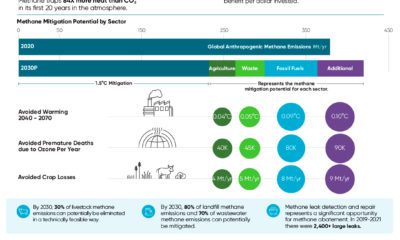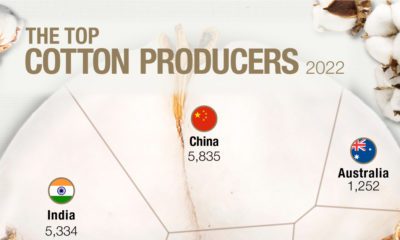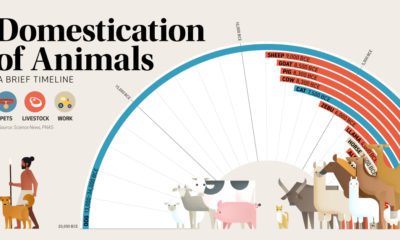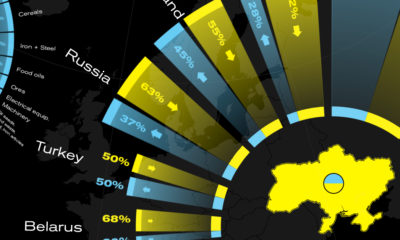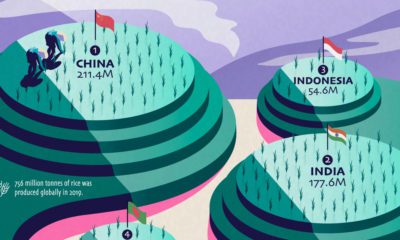Using data from USDA, this graphic looks at just how big the U.S. cheese stockpile has gotten over the last few years, and compares it to notable landmarks to help put things into perspective. But before diving into the data, we’ll take a step back to quickly explain why America’s cheese stockpile has gotten so big in the first place.
Why So Much Cheese?
Over the last 30 years, milk production in the U.S. has increased by 50%. Yet, while milk production has climbed, milk consumption has declined. In 2004, Americans consumed the equivalent of about 0.57 cups of milk per day. By 2018, average milk consumption had dropped to 0.33 cup-equivalents. In response to this predicament, the U.S. government and dairy companies have been purchasing the extra milk and storing it as cheese for years. So, where does one store such a large amount of cheese? A sizable portion of the stockpile is stored in a massive underground warehouse (a former limestone quarry) outside of Springfield, Missouri.
The Stockpile Keeps Growing
Apart from a small dip in 2021 during the global pandemic, America’s stockpile of cheese has increased steadily over the last five years: Between April 2018 and April 2022, U.S. cheese holdings increased by 130 million pounds to reach 1.48 billion pounds. After climbing up to 1.52 billion pounds in July, the stockpile settled once again at 1.48 billion pounds at the end of August 2022. Now, the U.S. cheese stockpile weighs more than the Eiffel Tower, Statue of Liberty, Tower of Pisa, and the Great Sphinx of Giza—combined.
Is the Cheese Stockpile Here to Stay?
Attempts have been made to get rid of the cheese stockpile. Over the years, the government has established federal food welfare programs and encouraged milk consumption in schools throughout the country. Yet, despite their best efforts to decrease the surplus, America’s cheese stockpile continues to grow. As domestic consumers continue to decrease their milk consumption, and switch out their dairy milk for milk alternatives like almond or oat milk, how much bigger will this cheese stockpile get before the government comes up with an alternative solution to deal with its surplus of dairy? on Over recent decades, farmers have been able to more than double their production of crops thanks to fertilizers and the vital nutrients they contain. When crops are harvested, the essential nutrients are taken away with them to the dining table, resulting in the depletion of these nutrients in the soil. To replenish these nutrients, fertilizers are needed, and the cycle continues. The above infographic by Brazil Potash shows the role that each macronutrient plays in growing healthy, high-yielding crops.
Food for Growth
Nitrogen, phosphorus, and potassium (NPK) are three primary macronutrients that are the building blocks of the global fertilizer industry. Each plays a key role in plant nutrition and promoting crop growth with higher yields. Let’s take a look at how each macronutrient affects plant growth. If crops lack NPK macronutrients, they become vulnerable to various stresses caused by weather conditions, pests, and diseases. Therefore, it is crucial to maintain a balance of all three macronutrients for the production of healthy, high-yielding crops.
The Importance of Fertilizers
Humans identified the importance of using fertilizers, such as manure, to nourish crops dating back to nearly 6,000 to 2,400 BC. As agriculture became more intensive and large-scale, farmers began to experiment with different types of fertilizers. Today advanced chemical fertilizers are used across the globe to enhance global crop production. There are a myriad of factors that affect soil type, and so the farmable land must have a healthy balance of all three macronutrients to support high-yielding, healthy crops. Consequently, arable land around the world varies in the amount and type of fertilizer it needs. Fertilizers play an integral role in strengthening food security, and a supply of locally available fertilizer is needed in supporting global food systems in an ever-growing world. Brazil is one of the largest exporters of agricultural goods in the world. However, the country is vulnerable as it relies on importing more than 95% of its potash to support crop growth. Brazil Potash is developing a new potash project in Brazil to ensure a stable domestic source of this nutrient-rich fertilizer critical for global food security. Click here to learn more about fertilizer and food production in Brazil.
